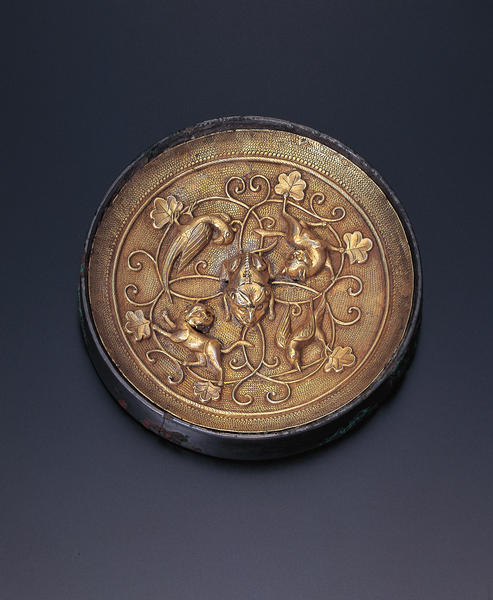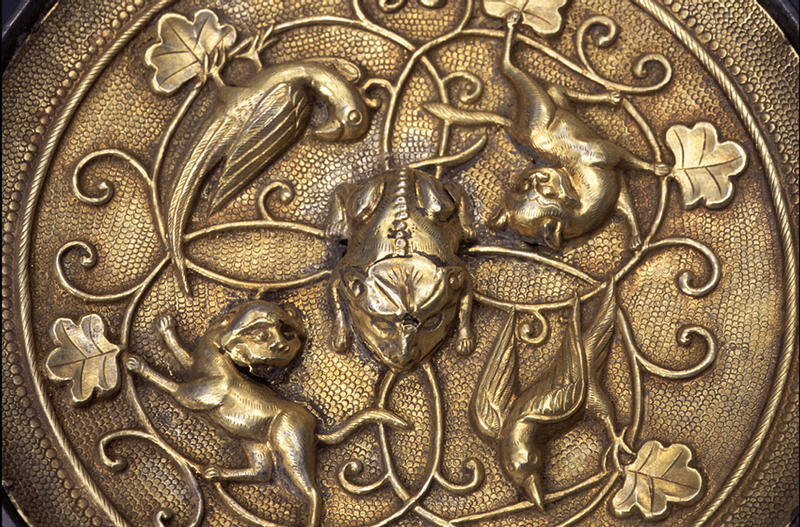Mirror with Repousse Designs
- China
- China, Tang period
- Late 7th to 8th centuries
- Bronze with Silver gilt inset
- H-0.9 D-7
Catalogue Entry
The ancients' reason for burying mirrors in Chinese tombs remains a mystery. Although crafted out of bronze, considered a precious material at the time, Shang-period mirrors seem to have had less status than bronze vessels. These early mirrors were simply made with few, if any, designs.1
By the Warring States period (481-221 B.C.) the popularity of mirrors had increased, and bronze discs were both decorative and symbolic, featuring innovative Chinese textile-derived patterns and auspicious emblems.2 By the Han period (206 B.C.-A.D. 220), concerns for one's immortality as well as one's good fortune here on earth replaced strictly decorative concerns, and this is reflected in the iconography of the mirrors created during this period. The increasing influence of Taoism helped, by the fourth to fifth centuries, usher in new mirror motifs associated with that philosophy.3 With the establishment of the Tang dynasty (A.D. 618-906), distinctive new decorative designs derived from outside China, such as those found on the Shumei example, were popular patterns for mirrors.
The Shumei mirror was initially cast in a two-part clay or stone mold.4 The reflecting surface was then polished to yield an image of the viewer, and the other side was inset with a decorated silver-gilt disk. A repouss and chased crouching mythical beast at the disc's center is surrounded by twin repouss and chased lions as well as a parrot and a swallow holding a floral spray.5 Grapes, leaves and vines, also repouss and chased, scroll among the bird and animal motifs. The entire composition is enclosed by two repouss and chased borders: one, a rope pattern; the other, a continuous pearl pattern. The remaining surface of the disk was decorated with small circular ring-matted designs before the entire silver disc was gilded.
The exact origin of the lion as an Chinese art motif is unclear. This ancient animal motif patterned artwork produced in various areas along the Silk Route as well as in India. By the Six Dynasties period (A.D. 420-589), lions were a popular subject in China, and images were created out of stoneware, are found on Buddhist and Zoroastrian stone sculpture, and were also primary motifs on fabric, with design influences from Sasanian Persia.6
Another popular Tang motif, grape leaves and vines, can be traced to sources outside of China. Grape leaves and vines pattern an Roman-Byzantine gilt bronze stem cup unearthed at Datong dating from the Northern Wei dynasty (A.D. 398-588), and this motif became a preferred mirror pattern in China during the Tang period.7 It was during this period that the art of fermenting grapes was first introduced to China from Turkistan, and wine became a symbol of luxury.8
Roundels rimmed with pearl borders enclosing pairs of birds and beast were popular Near Eastern and Central Asian patterns that traveled to China during the Six Dynasties period (A.D. 420-589). They reached their height of popularity as a decorative pattern during the Tang period, especially in textile design.9 Although the Shumei mirror motifs came from outside China, the Chinese were adept at assimilating and adapting such foreign design elements, resulting in objects with distinctive Chinese aesthetics.
Exquisite small mirrors, referred to as palm or pocket mirrors, were popular personal adornment items and were often carried inside small silk pouches attached to belts worn by the elite.10 The Shumei mirror is circular in form, but six-lobed versions featuring the same composition and motifs were also created. There is a six-lobed example in the Shanghai Museum, two six-lobed gilt mirrors in the Shaanxi Provincial museum, and a bronze six-lobed mirror with gilt disk has been found at a Tang tomb at Xinyan village Yanshi, Henan.11 In the West, the Pierre Uldry collection has a six-lobed example, as does the Seattle Art Museum; the Metropolitan Museum of Art in New York has a comparable round version.12
JMS
1. See Peng 1995, fig. 2, for an example of about 2000 B.C. unearthed from Duomatai, Guiman Xian, Qinghai province; see also Sun 1992, pp. 2-3, for two late-Shang-period mirrors from Anyang, Henan province, tomb of Fuhao in Sun Xianxing,
2. Segraves 1996b, pp. 48-50.
3. Ibid., pp. 50-53; Cahill 1983.
4. Technical information courtesy of Pieter Meyers and Richard H. Kimball.
5. On the swallow motif see cat. no. 132.
6. In 577 on the occasion of the marriage of Emperor Wu to a Western Turkistan princess, an exotic well-known Western Turkistan dance called the Dance of the Lions was first performed in China, adding to the popularity of this motif (see Cammann 1953, p. 282).
7. For two examples of Roman-Byzantine metal pieces patterned with grape, leaf, and vine motifs found in China see Wenwu 1990.5: p. 5, fig. 14, features a stem cup found at Datong; p. 2, fig. 1, shows a gilt plate unearthed in Gansu province.
8. Cammann 1953, pp. 274-75.
9. See Wu 1992, p. 127, pl. 86, for textile examples of birds within roundels holding floral sprays, and p.122, pl. 38, p. 126, pls. 84, 85, for animals within roundels.
10. For an example of a Tang-period male tomb figure wearing a mirror pouch see pottery figure unearthed at the Wuchang tomb in Zhou and Gao 1988, p. 279, pl. 392; for female court women wearing pouches see Shaanxi engraved tomb wall illustrated in Shanghai 1994, p. 111.
11. Chen 1987, pl. 80; for Shaanxi Provincial Museum examples see Gong and Han 1993, pp. 43-44.
12. Uldry 1994, pl. 186; Kelly 1984, p. 85, pl. 52; Metropolitan Museum 1996, p. 156.

